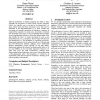Free Online Productivity Tools
i2Speak
i2Symbol
i2OCR
iTex2Img
iWeb2Print
iWeb2Shot
i2Type
iPdf2Split
iPdf2Merge
i2Bopomofo
i2Arabic
i2Style
i2Image
i2PDF
iLatex2Rtf
Sci2ools
GIS
2003
ACM
2003
ACM
Indexing of network constrained moving objects
With the proliferation of mobile computing, the ability to index efficiently the movements of mobile objects becomes important. Objects are typically seen as moving in two-dimensional (x,y) space, which means that their movements across time may be embedded in the three-dimensional (x,y,t) space. Further, the movements are typically represented as trajectories, sequences of connected line segments. In certain cases, movement is restricted, and specifically in this paper, we aim at exploiting that movements occur in transportation networks to reduce the dimensionality of the data. Briefly, the idea is to reduce movements to occur in one spatial dimension. As a consequence, the movement data becomes two-dimensional (x,t). The advantages of considering such lowerdimensional trajectories are the reduced overall size of the data and the lower-dimensional indexing challenge. Since off-the-shelf database management systems typically do not offer higherdimensional indexing, this reduction in ...
Database | Dimensionality-reduced Trajectories | GIS 2003 | Index Trajectories | Lowerdimensional Trajectories |
| Added | 11 Nov 2009 |
| Updated | 11 Nov 2009 |
| Type | Conference |
| Year | 2003 |
| Where | GIS |
| Authors | Dieter Pfoser, Christian S. Jensen |
Comments (0)

